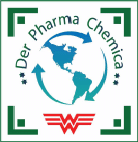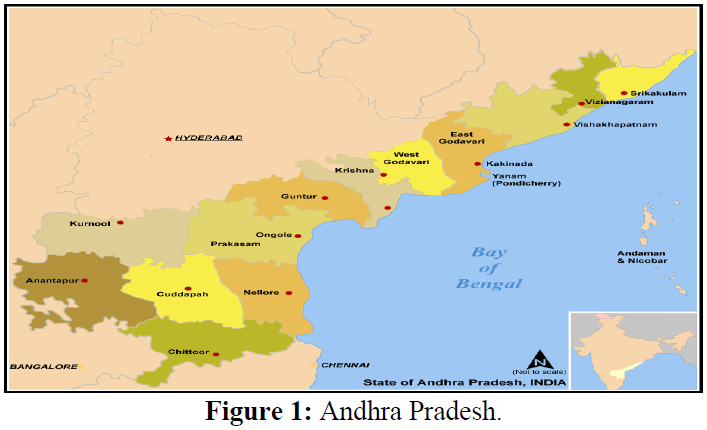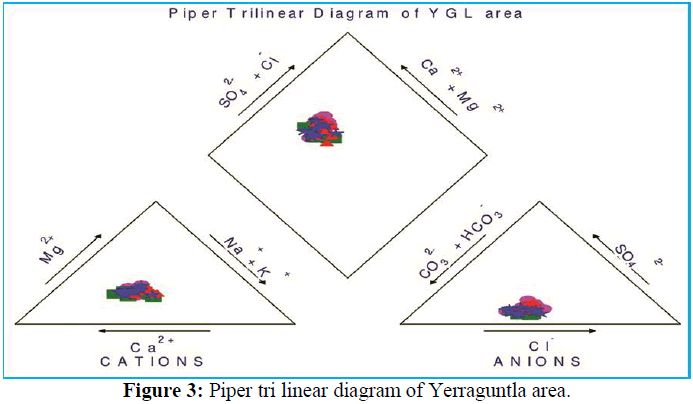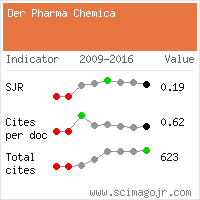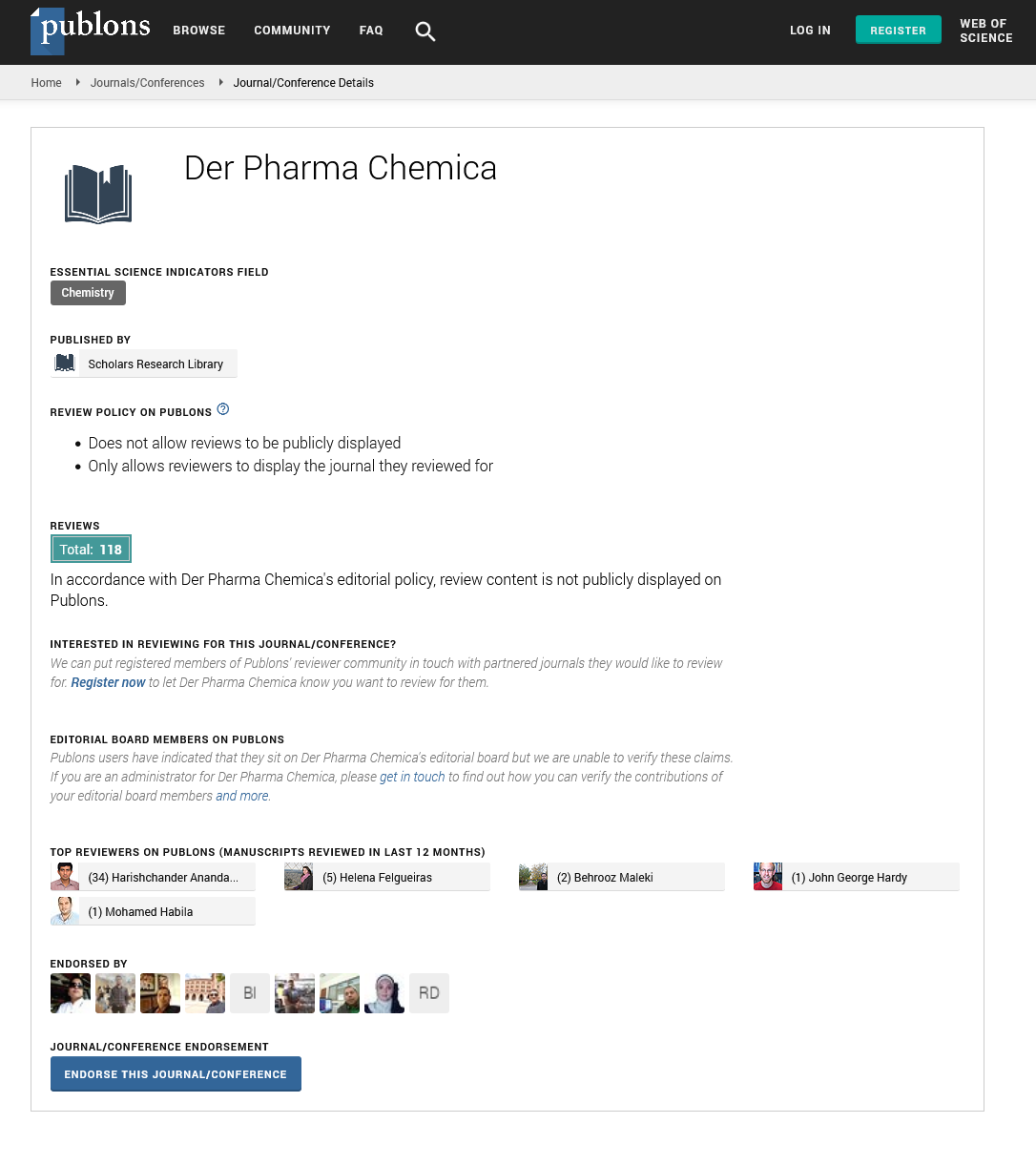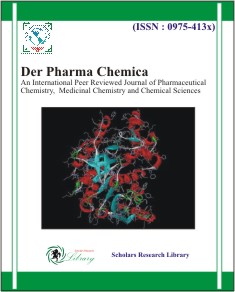Research Article - Der Pharma Chemica ( 2025) Volume 17, Issue 1
Seasonal Variation of Physico-Chemical Parameters of Groundwater in Yerraguntla Area of YSR Kadapa DT, AP-India
Suresh P1*, Bhagya Lakshmi K1, Beebi SK1, Priya Darshini S1, Sailaja G1 and Lakshmana Rao G22Department of Chemistry, Dr. V.S. Krishna Govt. Degree College(A), Visakhapatnam, Andhra Pradesh, India
Suresh P, Department of Chemistry, SRR and CVR Govt. Degree College(A), Vijayawada, Andhra Pradesh, India, Email: sure111333@gmail.com
Received: 01-Nov-2024, Manuscript No. DPC-25-151632; Editor assigned: 04-Nov-2024, Pre QC No. DPC-25-151632 (PQ); Reviewed: 18-Nov-2024, QC No. DPC-25-151632; Revised: 31-Jan-2025, Manuscript No. DPC-25-151632 (R); Published: 28-Feb-2025, DOI: 10.4172/0975-413X.17.1.621-624
Abstract
People on globe are under tremendous threat due to undesired changes in the physical, chemical and biological characteristics of air, water and soil. Due to increased human population, industrialization, use of fertilizers and man-made activity water is highly polluted with different harmful contaminants. Natural water contaminates due to weathering of rocks and leaching of soils, mining processing etc. It is necessary that the quality of drinking water should be checked at regular time interval, because of contaminated drinking water, human population suffers from varied of water borne diseases. The availability of good quality water is an indispensable feature for preventing diseases and improving quality of life. It is necessary to know details about different Physico-chemical parameters such as Hydrogen ion concentration, Electrical Conductivity, Total Dissolved Solids, Total Hardness, Calcium, Magnesium, Sodium, Potassium, bicarbonate, Chloride, Sulphate, Phosphate, Dissolved Oxygen, Biochemical Oxygen Demand, Chemical Oxygen Demand etc. for testing water quality. Yerraguntla area of YSR kadapa district was selected to determine the groundwater quality in monsoon and summer seasons. In the present investigation, the results showed that most of the Physico-chemical parameters exceeded the permissible limits of WHO. The water quality index showed that groundwater is not suitable for drinking purpose in all locations of the study area. The correlation coefficient (r) showed the inter dependency of various parameters that influence groundwater quality. Piper tri linear diagram showed that the groundwater of the area contains Ca-HCO3 type of salts. So, it is necessary to adopt sound water purification methods in the study area.
Keywords
Industrialization; Contamination; Physico-chemical parameters; Water quality index; Correlation; Piper diagram; Purification
Introduction
Groundwater refers to all the water occupying the voids, pores and fissures within geological formations, which originated from atmospheric precipitation either directly by rainfall infiltration or indirectly from rivers, lakes or canals. Sands, gravel, sandstones and limestone formations are the usual sources of groundwater supply though some may be drawn from impervious rocks such as granite when they have an over burden of sand or gravel. Groundwater is a valued fresh water resource and constitutes about two-third of the fresh water reserves of the world [1]. The ground water reservoir of the world is more than 2,000 times the volume of waters in all the world’s rivers and more than 30 times the volume contained in all the world’s fresh water lakes [2].
The groundwater accounts for about 50% of livestock and irrigation usage and just under 40% of water supplies, whilst in rural areas, 98% of domestic water use is from groundwater [3]. Utilization of groundwater as a source for domestic, municipal, agricultural and industrial activities continue to increase principally because of the heavy capital outlay and maintenance of surface water development through dams especially in developing countries [4]. Another factor which is responsible for the attention being diverted to this source is improved technology manifest by deep boring in form of borehole which satisfies WHO drinking water quality standard [5]. Groundwater is abstracted through hand-dug wells; hand-pump operated shallow-wells and submersible pump operated deep well or boreholes [6]. Groundwater is often high in mineral content such as magnesium and calcium salts, iron and manganese depending on the chemical composition of the stratum through which the rock flows.
Industrial development results in the generation of industrial effluents and the untreated water results in sediment and soil pollution. Having mainly excessive amounts of heavy metals such as Pb, Cr and Fe, as well as heavy metals from industrial processes are of special concern because they produce water or chronic poisoning in aquatic animals [7]. High levels of pollutants mainly organic matter in river water because an increase in biological oxygen demand [8], chemical oxygen demand, total dissolved solids, total suspended solids and fecal coli form which make water unsuitable for drinking, irrigation or any other use [9]. Hardness is the property of water, which prevents the lather formation with soap and increases the boiling points of water [10]. Hardness of water mainly depends upon the amount of calcium or magnesium salts or both. Sodium is used in the normal functioning of some processes in the human body and as such is an essential element but its high concentration may adversely affect the cardiac, renal and circulatory functions [11]. Soil porosity and permeability also has a key role in building up the chlorides concentration. Excessive chloride concentration increase rates of corrosion of metals in the distribution system. This can lead to increased concentration of metals in the supply [12]. Sulphate occurs naturally in water as a result of leaching from gypsum and other common minerals. Sulphate content in drinking water exceeding the 400 mg/L impart bitter taste and may cause gastro-intestinal irritation [13]. Phosphate may occur in ground water as a result of domestic sewage, detergents, agricultural fertilizers and industrial waste water [14].
Dissolved oxygen is important parameter in water quality assessment and biological processes prevailing in the water. The DO values indicate the degree of pollution in the water bodies. The higher value of dissolved oxygen can impart good aesthetic taste to drinking water. BOD is a chemical procedure for determining the amount of dissolved oxygen needed by aerobic biological organisms in a body of water to break down organic material present in a given water sample at certain temperature over a specific time period. The COD test is commonly used to indirectly measure the amount of organic compounds in water [15]. Most applications of COD determine the amount of organic pollutants found in surface water making COD a useful measure of water quality.
It is very essential and important to test the water before it is used for drinking, domestic, agricultural or industrial purpose. Water contains different types of floating, dissolved, suspended and microbiological as well as bacteriological impurities. Water must be tested with different physico-chemical parameters like temperature, color, odour, pH, turbidity, TDS, calcium, magnesium, sodium, potassium, carbonate, bicarbonate, fluoride, chloride, nitrate, sulphate, phosphate etc, while chemical tests should be performing for its bio-chemical oxygen demand, chemical oxygen demand, dissolved oxygen, alkalinity, hardness and other characterstics. The statistical data is further tested and correlated using water quality index, correlation coefficient etc. The suitability of water sources for human consumption has been described in terms of Water Quality Index (WQI), which is one of the most effective ways to describe the quality of water. The correlation analysis enables us to have an idea about the degree & direction of the relationship between the two variables under study. Karl Pearson’s coefficient, is a simplified statistical tool to show the degree of dependency of one variable to the other.
Materials and Methods
Study area
Yerraguntla Municipal Town in YSR Kadapa district (Figure 2) is located in Andhra Pradesh (Figure 1). The area is located at 14.6333N and 78.5333E coordinates with an elevation of 152 meters. This is dominantly an arenaceous consisting of conglomerate quartzite, Quartzite with shale formation of dolomitic lime stones. The main factors that control the quality of water are associated with lithology and soil. Water quality may vary depending upon variations in geological formations.
Sample collection
Ten water Samples from different areas of Yerraguntla area were collected in polythene bottles by following the standard protocols. The collected water samples were analyzed for different physico-chemical parameter such as for pH (Hydrogen Ion concentration), Electrical Conductivity (EC), Total Dissolved Solids (TDS), Total Hardness (TH), Calcium (Ca2+), Magnesium (Mg2+), Sodium (Na+), Potassium (K+), Bicarbonate (HCO3-),Chloride (Cl-), Sulphate (SO42-) Phosphate (PO43-), Dissolved Oxygen (DO), Biochemical Oxygen Demand (BOD), Chemical Oxygen Demand (COD).
Methodology
The physico-chemical parameters of samples were analyzed according to the procedure prescribed by APHA and BIS. pH was determined by pH meter; EC was determined by conductometer; TDS was determined by TDS meter; TH, Ca, Mg, HCO3 and Cl were determined by titration method; SO4, PO4, F, NO3, DO, BOD and COD were determined by UV-V is spectrophotometer.
Results and Discussion
The quality of different groundwater samples has been carried out hydrogen ion concentration, electrical conductivity, total dissolved solids, total hardness, calcium, magnesium, sodium, potassium, bicarbonate, chloride, sulphate, phosphate, dissolved oxygen, biochemical oxygen demand, chemical oxygen demand and the results are shown
pH
pH is a measure of the hydrogen ion concentration in water and indicates whether the water is acidic or alkaline. The measurement of alkalinity and acidity of pH is required to determine the corrosiveness of the water. The standard values of pH for drinking water by BIS is 6.5-8.5 while, WHO is 6.5-9.2.
In YGL area, pH was determined in the range of 7.2-7.5 with a mean of 7.35 during monsoon, 7.4-7.9 with a mean of 7.66 during summer 7.1-7.5 with a mean of 7.31 in monsoon. In all seasons, pH was found within the permissible limit.
Electrical Conductivity (EC)
Conductivity is ability of water to carry an electrical current. This ability mainly depends on presence of anion and cations in water and also depends on mobility, valence of ions and temperature. The most desirable limit of EC in drinking water is prescribed as1500 μS/cm. Thus, the EC can be classified as type I, if the enrichments of salts are low (EC<1500 μS/cm); type II, if the enrichment of salts are medium (EC: 1500 and 3000 μS/cm) and type III, if the enrichments of salts are high (EC>3000 μS/cm).
In YGL area, during monsoon season, EC of groundwater was observed in the range of 2156-3587 μS/cm with a mean of 3026.1 μS/cm. In this season, four samples fall under Type-II and six samples fall under Type-III. In summer season, EC was found in the range of 1736-3120 μS/cm with a mean of 2375.3 μS/cm. During this season, eight samples fall under Type-II and two samples fall under Type-III.
Total Dissolved Solids (TDS)
Water source in its natural form itself might contain a variable quantity of inorganic salts dissolved in it. Degree of groundwater quality can be classified as “fresh”, if the TDS is less than 1,000 mg/L; “brackish”, if the TDS is between 1,000 and 10,000 mg/L; “saline”, if the TDS is varied from 10,000 to 1,000,000 mg/L; and brine, if the TDS is more than 1,000,000 mg/L.
In YGL area, during monsoon and summer seasons, TDS was found in the range of 1207-2189 mg/L with a mean of 1660.8 mg/L, 851-1611 mg/L with a mean of 1170.7 mg/L respectively. The groundwater quality of this area was categorized as “brackish” type in all seasons.
Total Hardness (TH)
In YGL area, during monsoon and summer seasons, TH was found in the range of 856-1669 mg/L with a mean of 1236.3 mg/L, 573-1235 mg/L with a mean of 789.7 mg/L respectively. In all seasons, TH of all samples was found above permissible limit.
Calcium (Ca)
Calcium is directly related to hardness and is the chief cation in the water. In YGL area, during monsoon and summer seasons, calcium was found in the range of 121-256 mg/L with a mean of 176.6 mg/L, 89-215 mg/L with a mean of 142.7 mg/L respectively. All samples in both seasons contained calcium above the permissible limit. If calcium is present beyond the maximum acceptable limit, it causes incrustation of pipes, poor lathering and deterioration of the quality of clothes.
Magnesium (Mg)
Magnesium is directly related to hardness in YGL area, magnesium was observed in the range of 46-78 mg/L with a mean of 60.9 mg/L, 29-65 mg/L with a mean of 47.4 mg/L during monsoon and summer seasons respectively. During monsoon, 90% of samples contained magnesium above the permissible limit of WHO and all samples above BIS limit. In summer, 40% of samples contained magnesium above permissible limit of WHO and 90% of samples above BIS.
Sodium (Na)
In YGL area, during monsoon and summer seasons, sodium was found in the range of 65-144 mg/L with a mean of 106.6 mg/L, 62-128 mg/L with a mean of 94.6 mg/L respectively. All samples of this area contained sodium within the permissible limit during study period.
Potassium (K)
Natural waters normally contain low concentration of Potassium. High values of potassium may indicate some pollution of ground water. In YGL area, during monsoon and summer seasons, potassium was found in the range of 24-47 mg/L with a mean of 33.8 mg/L, 16-41 mg/L with a mean of 27.9 mg/L respectively. Potassium concentration in all samples was observed above permissible limit during study period.
Bicarbonate (HCO3-)
In YGL area, during monsoon and summer seasons, Bicarbonate was found in the range of 536-805 mg/L with a mean of 677.3 mg/L, 362-669 mg/L with a mean of 494.4 mg/L respectively. All samples during all seasons contained bicarbonate more than permissible limit.
Chloride (Cl-)
In YGL area, chloride was observed in the range of 225-401 mg/L with a mean of 330.5 mg/L, 186-312 mg/L with a mean of 225.6 mg/L during monsoon and summer seasons respectively. During monsoon, all samples contained chloride above the permissible limit of WHO and 90% of samples contained above BIS permissible limit. In summer, 80% of samples contained chloride above permissible limit of WHO and 20% of samples above BIS limit. The higher values of chloride can cause corrosion and pitting of iron pipes and plates.
Sulphate (SO42-)
In YGL area, sulphate was observed in the range of 97-278 mg/L with a mean of 161.8 mg/L, 45-159 mg/L with a mean of 81.1 mg/L during monsoon and summer seasons respectively. 20% of samples during monsoon contained sulphate above permissible limit and all samples during summer contained sulphate within the permissible limit.
Phosphate (PO43-)
The permissible limit of phosphate in drinking water is 1mg/L according to WHO and BIS guidelines. In YGL area, phosphate was observed in the range of 0.84-1.31 mg/L with a mean of 1.081 m/L, 0.71-1.62 mg/L with a mean of 1.166 mg/L during monsoon and summer seasons respectively. Phosphate in 70% of samples during monsoon and summer exceeded the permissible limit.
Dissolved Oxygen (DO)
In YGL area, during monsoon and summer seasons, DO was found in the range of 5.84-8.06 mg/L with a mean of 6.811 mg/L, 5.21-6.56 mg/L with a mean of 6.068 mg/L respectively. DO in 40% of samples during summer, 20% in monsoon were found below 6 mg/L. However, the mean DO of all samples during both seasons was found above 6 mg/L as per the prescribed level of WHO and BIS.
Biochemical Oxygen Demand (BOD)
In YGL area, BOD was observed in the range of 0.84 mg/L-2.26 mg/L with a mean of 1.342 mg/L, 0.79 mg/L-2.32 mg/L with a mean of 1.413 mg/L during monsoon and summer seasons respectively. BOD of all samples in all seasons was observed within the permissible limit.
Chemical Oxygen Demand (COD)
In YGL area, COD was observed in the range of 1.48 mg/L-3.24 mg/L with a mean of 2.23 mg/L, 1.36 mg/L-2.65 mg/L with a mean of 2.123 mg/L during monsoon and summer seasons respectively. COD of all samples in all seasons was observed within the permissible limit.
Water Quality Index (WQI)
Water quality index can be classified into five types. WQI in the range of 0-25 is rated as “Excellent water quality” and graded as “A”. WQI in the range of 26-50 is rated as “Good water quality” and graded as “B”. WQI in the range of 51-75 is rated as “poor water quality” and graded as “C”. WQI with 76-100 is rated as “very poor water quality” and graded as “D”. WQI more than 100 is rated as “unfit for drinking” and graded as “E”. In YGL area, during monsoon season, WQI of 90% samples was found more than 100 and hence categorized as “unfit for drinking”. In summer season, all samples fall under “unfit for drinking” type.
Correlation coefficient (r)
The statistical analysis of this area during monsoon season, EC was strongly correlated to TDS, TH, Ca, Mg, Cl, SO4 and F (r>0.808-0.931). TDS was correlated from moderate to strong with all parameters except PO4. TH was strongly correlated to Ca, Mg, Cl and SO4 (r>0.849-0.932). Bivalent ions Ca and Mg are correlated from strong to moderate with HCO3, Cl and SO4 (r>0.658-0.933). This suggests that groundwater of this area was mixed type of Ca-Mg-HCO3-Cl-SO4 salts.
The results of summer season indicate that EC, TDS and TH are strongly correlated to Ca, Mg, HCO3, Cl and SO4 which indicate the interdependency of all these parameters. Ca was strongly correlated to HCO3, Cl and SO4 (r=0.820-0.975). Mg was strongly correlated to HCO3 (r>0.926) and moderately correlated to SO4 (r>0.735).
Piper tri linear diagrams
In YGL area, cation and anion triangles showed that no ions are dominant in all seasons. The groundwater of this area contained Ca-HCO3 type of salts during all seasons according to diamond shaped field (Figure 3).
Conclusion
The overall water quality of the study area signifies that the groundwater is not suitable for drinking in studied seasons. The reason for dwindling quality of water in this region may be due to weathering of rocks and anthropogenic activities. The drinking water source in the study area was exposed to more than one of the anthropogenic sources of contaminations such as sewage percolation, septic tank and agricultural practices. Finally, it can be concluded that monitoring system is to be established to periodically evaluate the water quality. A registry of periodically evaluated water quality parameters of drinking water may be kept with local administration, for the benefit of public health providers, health professionals and the public.
References
- Chilton J. Waterlines J. 1992; 2(110): p. 2-4.
- Buchanan. J Ground Water. 1983: p. 193-200.
- Todd K. 2nd Edition. John Wiley & Sons. Chichester, New York, USA. 1980.
- Sangodoyin AY, Agbawhe OM. Bioresour Technol. 1992; 41(3): p. 193-200.
- Misra SG, Dinesh D. Ashing Publishing House. New Delhi, India. 1991.
- Ellis KV. Macmillan press Ltd. Hound mill, Basingstoke, Hampshire RG. 1989; 21: p. 3-18.
- Kulkarni GJ. 10th Edition, Farooq Kitabs Ghar, Karachi. 1997: p. 497.
- Hari OS, Nepal MS, Aryo, et al. J Environ Biol. 1994; 3(15): p. 171-175.
- Rice EW, Bridgewater L. 20th Edition. American Public Health Association. Washington DC, USA. 1998.
- Rajesh Kumar SS, Yadav. Int J Chem Sci. 2011; 9(1): p. 440-447.
- De A.K. 4th Edition, New Age International Publishers, New Delhi, India. 2002: p. 245-252.
- Shrinivasa Rao B, Venkateswaralu P. Indian J Environ Prot. 2000; 20(3): p. 161.
- Jain CK. Water Res. 2002; 36(5): p. 1262-1274.
[Crossref] [Google Scholar] [PubMed]
- Parashar C, Dixit S, Shrivastava R. Asian J Exp Sci. 2006; 20(2): p. 297-302.
- Patil VT, Patil PR. J Chem. 2010; 7(1): p. 111-116.
